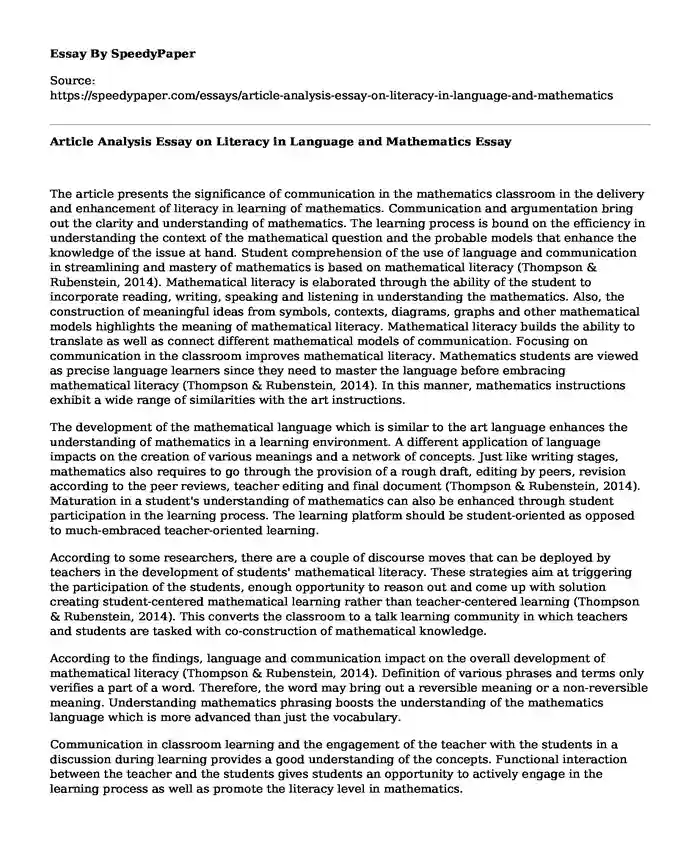
| Type of paper: | Article review |
| Categories: | Communication Pedagogy Languages Mathematics |
| Pages: | 3 |
| Wordcount: | 610 words |
The article presents the significance of communication in the mathematics classroom in the delivery and enhancement of literacy in learning of mathematics. Communication and argumentation bring out the clarity and understanding of mathematics. The learning process is bound on the efficiency in understanding the context of the mathematical question and the probable models that enhance the knowledge of the issue at hand. Student comprehension of the use of language and communication in streamlining and mastery of mathematics is based on mathematical literacy (Thompson & Rubenstein, 2014). Mathematical literacy is elaborated through the ability of the student to incorporate reading, writing, speaking and listening in understanding the mathematics. Also, the construction of meaningful ideas from symbols, contexts, diagrams, graphs and other mathematical models highlights the meaning of mathematical literacy. Mathematical literacy builds the ability to translate as well as connect different mathematical models of communication. Focusing on communication in the classroom improves mathematical literacy. Mathematics students are viewed as precise language learners since they need to master the language before embracing mathematical literacy (Thompson & Rubenstein, 2014). In this manner, mathematics instructions exhibit a wide range of similarities with the art instructions.
The development of the mathematical language which is similar to the art language enhances the understanding of mathematics in a learning environment. A different application of language impacts on the creation of various meanings and a network of concepts. Just like writing stages, mathematics also requires to go through the provision of a rough draft, editing by peers, revision according to the peer reviews, teacher editing and final document (Thompson & Rubenstein, 2014). Maturation in a student's understanding of mathematics can also be enhanced through student participation in the learning process. The learning platform should be student-oriented as opposed to much-embraced teacher-oriented learning.
According to some researchers, there are a couple of discourse moves that can be deployed by teachers in the development of students' mathematical literacy. These strategies aim at triggering the participation of the students, enough opportunity to reason out and come up with solution creating student-centered mathematical learning rather than teacher-centered learning (Thompson & Rubenstein, 2014). This converts the classroom to a talk learning community in which teachers and students are tasked with co-construction of mathematical knowledge.
According to the findings, language and communication impact on the overall development of mathematical literacy (Thompson & Rubenstein, 2014). Definition of various phrases and terms only verifies a part of a word. Therefore, the word may bring out a reversible meaning or a non-reversible meaning. Understanding mathematics phrasing boosts the understanding of the mathematics language which is more advanced than just the vocabulary.
Communication in classroom learning and the engagement of the teacher with the students in a discussion during learning provides a good understanding of the concepts. Functional interaction between the teacher and the students gives students an opportunity to actively engage in the learning process as well as promote the literacy level in mathematics.
The article highlights the critical fundamentals in establishing a literacy level in the learning of mathematics. It is apparent that the language use fosters mathematical literacy as communication is key to the interpretation of concepts and the models, symbols, graphs, and diagrams in mathematical operations. I agree with the postulations of the article with regards to the link created by instruction language and its impact on communication as well as the resulting outcome in the relationship established between the teacher and the student. The information in the article is presented in a friendly language easy to understand and apply in the standard classroom setting.
Reference
Thompson, D. R., & Rubenstein, R. N. (2014). Literacy in Language and Mathematics. Journal of Adolescent & Adult Literacy, 58(2), 105-108. https://doi.org/10.1002/jaal.338
Cite this page
Article Analysis Essay on Literacy in Language and Mathematics. (2022, Dec 15). Retrieved from https://speedypaper.com/essays/article-analysis-essay-on-literacy-in-language-and-mathematics
Request Removal
If you are the original author of this essay and no longer wish to have it published on the SpeedyPaper website, please click below to request its removal:
- Literary Essay Sample: How Pope Uses Animal Imagery in Essay on Man
- Love Without Boundaries - Essay Samples for You to Choose From
- Essay Sample on Unethical Behaviors in Forensic Science
- Is Video Gaming a Sport? Article Analysis Essay Example
- Free Essay Describing Success and Failure of the War on Poverty
- Rationale Essay for a Degree Program in Business Management and Economics
- Essay Sample on Educator Preparation Program
Popular categories




